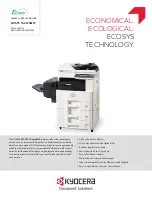
General Information
1-63
Drum Preparation
To prepare the drum, a thin, intermediate liquid transfer surface is
applied to the surface of the drum. (Refer to Figure 1-28.) First the
drum is rotated to a speed of 51 cm per second (20 inches per second).
Next, the oil roller and blade of the maintenance drawer are raised
into contact with the drum. To accomplish this, the process motor
rotates clockwise, driving the process drive belt and the compound
gear. Rotating clockwise, the compound gear drives a gear train that
drives the maintenance camshaft’s 3-position electric clutch which, in
turn, engages the maintenance drawer camshaft. The maintenance
drawer camshaft clutch energizes to release the 3-position clutch,
allowing it and the camshaft to rotate about one-half revolution to the
next stop. The cams on the ends of the camshaft push against
followers on each side of the maintenance drawer, forcing the oil roller
and blade against the drum. The de-energized clutch holds the
camshaft in this position.
As the drum nears the end of its rotation, the clutch energizes for a
moment, allowing the camshaft to rotate further; this lowers the oil
roller but leaves the blade in contact with the drum to smooth out the
last of the oil on the drum.
The clutch energizes for a third time to allow the camshaft to rotate
to its home position, and lower the blade. The point at which the blade
ends contact with the drum leaves a bead of oil, called an oil bar. The
oil bar defines the edge of a 40 mm (1.5 in.) swath of the drum which
is not oiled; this swath is called the deadband. No ink will be
deposited on the deadband during the print cycle. Instead, the paper
stripper fingers, which lift the paper off of the drum during printing,
are lowered into contact with the drum in the deadband. This keeps
them from accumulating any oil on their fingertips which would stain
the edge of the print as it is stripped off of the drum.
At this point, the drum starts rotating again at a speed dependent
upon print resolution. As the drum reaches the correct speed, the ink-
jets begin to fire to deposit the image on the oiled portion of the drum.
As the jets fire, the printhead slews in the X-axis to complete the
image on the drum.
Summary of Contents for Nuvera 100
Page 1: ...General Information 1 1 Chapter...
Page 24: ...1 24 ii LINX Solid Inkjet 100 Service Manual 1239 35b Figure 1 13 Repacking the Printer...
Page 27: ...General Information 1 27...
Page 28: ...1 28 ii LINX Solid Inkjet 100 Service Manual...
Page 79: ...Error Codes and Messages 2 1 Chapter...
Page 101: ...Troubleshooting 3 1 Chapter...
Page 145: ...Adjustments 4 1 Chapter...
Page 180: ...4 36 ii LINX Solid Inkjet 100 Service Manual...
Page 181: ...Cleaning and Maintenance 5 1 Chapter...
Page 190: ...5 10 iiLINX Solid Inkjet 100 Service Manual...
Page 191: ...Removal and Replacement 6 1 Chapter...
Page 249: ...Printer Networking 7 1 Chapter 7...
Page 280: ...7 32 ii LINX Solid Inkjet 100 Printer Service Manual...
Page 281: ...Material Number Listings A 1 Appendix...
Page 285: ...Material Number Listings A 5 7 5 6 8 1 2 4 0388 21 3 Figure A 1 Cabinet parts...
Page 289: ...Material Number Listings A 9 0388 16 2 1 5 11 10 9 12 6 4 3 7 13 8 Figure A 3 Paper Path Parts...
Page 291: ...Material Number Listings A 11 0388 14 7 4 3 5 6 2 1 Figure A 4 Motor and Fan Parts...
Page 295: ...Material Number Listings A 15 4 5 3 2 1 0388 23 Figure A 6 Solenoid and Clutch Parts...
Page 304: ...A 24 ii LINX Solid Inkjet 100 Service Manual...
















































